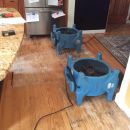
Water Extraction After a Flood
After a flood it is critical that you remove any standing water as quickly as possible to prevent additional damage and mold growth. When time is of the essence, a professional restoration team can bring in industrial equipment to remove any standing water. Industrial dehumidifiers can dry out the area further, eliminating underlying moisture that can create a breeding ground for mold.
Remove Standing Water Quickly
Any standing water should be immediately removed after a flood. This may involve employing a shop-vac or a pump to suck up the water. You can also do this with old-fashioned buckets, but this is not as effective or expeditious. To effectively remove all of the water, the furniture and other items need to be removed from the area. Items that have come into contact with the water will need to be set out to dry or thrown away. In many cases, the flooring will also need to be taken up, particularly in the case of carpeting, in order to remove all of the excess moisture and allow the room to dry out.
Drying Out the Area
Once the standing water has been removed, the moisture levels will still be extremely high. Flooring, drywall and even woodwork can quickly absorb moisture after a flood. These high humidity levels can lead to big problems with mold growth. It is important to dry the area as efficiently as possible. For this step, ventilation is key. Open any doors and windows to allow the air to circulate. Dehumidifiers can go a long way to speeding up the process, particularly industrial sized units that are best suited for a flooded area.
Any time there is excessive water in your home or business, you need to act quickly to remove the standing water and get moisture levels back under control. A professional restoration team like Soil-Away can make sure this is done quickly and efficiently, minimizing any further water damage that could result.
If a flood has affected your home or business, contact Soil-Away at 603-641-6555.

